
34 Journal of Mining and Earth Sciences, Vol 65, Issue 6 (2024) 34 - 46
Research on the application of wellbore strengthening
methodology and managed pressure drilling for HTHP
wells in highly depleted reservoirs at the Nam Con Son
basin
Tai Trong Nguyen 1,*, Charles Dunne 1, Vinh The Nguyen 2, Thinh Van Nguyen 2, Tu
Van Truong 2
1 Zarubezhneft EP Vietnam B.V, Hochiminh City, Vietnam
2 Hanoi University of Mining and Geology, Hanoi, Vietnam
ARTICLE INFO
ABSTRACT
Article history:
Received 23rd June 2024
Revised 15th Oct. 2024
Accepted 09th Nov. 2024
The gas production in high-temperature, high-pressure (HTHP) projects in
the Nam Con Son basin is entering a declining production phase, the
production duration almost reaching the final phase of the designed field
life. Therefore, the need to build a development plan for maintaining and
supplementing gas production is the most important in the current phase.
Evaluation of gas field conditions, drilling infill wells to expand existing
prospects is considered a feasible solution both technically and
economically. However, the physical characteristics of the production
reservoirs have changed after a long production time, including a decrease
in pore pressure at the production reservoirs, posing a significant technical
challenge during the drilling operations. The infill wells are required to
penetrate through the shale formations interbedded with sand formations.
In there, the cap rock shale layer remains at or close to virgin pressure and
the sand reservoir with pore and fracture pressures has largely decreased
due to production activities. There is no mud-weight window that exists any
more at the transition between cap rock and reservoirs which leads to
drilling problems such as loss circulation, gas kicks and especially, the well
could not reach the total desired depth or production targets which impact
to overall development project. This article evaluates the applicability of a
combination of technologies, including utilizing special lost circulation
materials to seal the fractures due to changes in reservoir properties and
the application of managed pressure drilling methodologies while drilling
through infill wells in HTHP conditions. The goal is to minimize the risks of
well problems and provide the management of uncertainties during the
drilling which improves project efficiency.
Copyright © 2024 Hanoi University of Mining and Geology. All rights reserved.
Keywords:
Depleted reservoir,
Lost circulation/fracture
gradient,
Nam Con Son,
Offshore HTHP field,
Wellbore strengthening,
_____________________
*Corresponding author
E - mail: tai.n.trong@gmail.com
DOI: 10.46326/JMES.2024.65(6).04

Tai Trong Nguyen et al./Journal of Mining and Earth Sciences 65 (6), 34 - 46 35
1. Introduction
Referring to the database in Vietnam in recent
years, the production rate of gas and condensate by
operators operating HTHP projects at the Nam Con
Son basin contributes more than 18% of the total
production rate of barrel oil equivalent (BOE) in
Vietnam.
The major gas and condensate produced in
this basin are mostly distributed across multiple
sandstone reservoirs in the Miocene strata.
Generally, the reservoir quality is good,
characterized by a high net-to-gross ratio, good
porosity, and low water saturation. The sandstone
formations are typically composed of clean, very
fine to fine quartz grains and are commonly loose,
although occasionally cemented by calcite or
argillaceous matrix, resulting in relatively poor
visible porosity.
HTHP area is located in the centre of the basin,
which is one of highest highest-profile HTHPs in
Vietnam. The production reservoirs lie from upper
to middle Miocene formations, the depth in the
range of 3,200÷3,800 m TVD SS (true vertical
depth below mean sea level). Its original pore
pressure was 16.0÷17.0 ppg, the maximum
fracture gradient in the production zone is 18.5 pg,
and the bottom hole temperature is up to 2030C.
(Avirup & Amita, 2015; Scott, 2023). The
hydrocarbon production consists of gas and
condensate with a maximum of 5÷7% CO2, no H2S.
The first production well at the Nam Con Son
basin commenced providing the first gas more
than a decade ago. Therefore, with the ongoing gas
and condensate production activities, the
reservoirs shall be depleted (Maurice, 2001), as
indicated below:
- A reduction of pore pressure and fracture
pressure in the depleted zone.
- The change of rock mechanic properties
affects the wellbore stability.
The expected reservoir pore pressure and
wellbore stability prediction were taken based on
the results of geomechanical modelling; and the
analysis of PLT data was recorded from offset
production wells. The depleted pressure and
fracture gradient in a typical production well at the
Nam Con Son basin are shown in Figure 1.
Referring to the picture above for wells drilled
before depletion occurs, a mud-weight window
exists between the pore pressure and the fracture
pressure. The minimum mud window is in the
range of 0.8÷1.2 ppg which could apply the
conventional drilling methodology for
exploration/appraisal and production wells. When
depletion occurs, the fracture pressure in the
reservoir decreases along with the pore pressure.
At the interface between the cap rock, which
remains at virgin pressure, and the depleted
reservoir, there are no mud-weight windows
anymore (Fambon & Joffroy, 2008).
1.1. Pore pressure & Fracture gradient profile
The results of pore pressure prediction
modeling and logging data from the offset HTHP
wells drilled in the Nam Con Son basin indicated a
normal trend of pore pressure and fracture
gradient from the seabed to the expected top of the
Middle Miocene strata at a depth of approximately
2,100 m TVD SS. Subsequently, an abnormal pore
pressure and fracture gradient occurred in the
MMU (Middle Miocene Unconformity) at a depth of
approximately 3,100 m TVD SS. The pressure
gradient in this interval increased up to 0.6÷0.8
ppg/100 m with pore pressure reaching 16.9 ppg
(Scott, 2023).
The reservoir zones are located from MMU to
the bottom of the Miocene strata with an initial
stable trend of pore pressure and fracture gradient.
There are five main sand zones interbedded with
shales as follows:
- The A sand formation with an average gross
thickness of 10÷18 m, the reservoir properties are
quite good with fair permeability (average 34 mD),
porosity is generally good to very good (average
24%) and high gas saturation in pay zones (10%).
Within more than a decade in production, the
monitoring of existing production and pore
pressure prediction results had shown the average
pressure of depletion is 90 psi per year.
- The B sand formation is a major production
zone with an average gross thickness of 110÷250m
depending on the well location. This thick section
comprised clay units interbedded with shale
sandstone layers of varying thickness. The
reservoir qualities are quite good with fair
permeability (average 47 mD ), porosity is
generally good (average 14%) and high gas
saturation in pay zones (9%). The reservoir is
comprised of interbedded shale therefore the

36 Tai Trong Nguyen et al./Journal of Mining and Earth Sciences 65 (6), 34 - 46
depletion of pressure occurred in this formation in
various values, and maximum depletion will be at
the bottom of the reservoir. The average pressure
of depletion is 190 psi per year
- The C sand formation with a gross thickness
of approximately 50÷70 m, the interval comprises
a thin high porosity carbonate underlain by the
interbedded sand and shale sub-sequence with
high quality reservoir properties. The permeability
(average 55 mD), and porosity are generally good
with an average of 16% and high gas saturation in
pay zones (35%).
In general, the properties of this formation are
similar to the above sand formation with the
average pressure of depletion is 190 psi per year.
- The D sand reservoir has a quite good gross
thickness interval of approximately 50÷80 m, there
are several reservoir quality beds. The
permeability (average 50 mD), porosity is
generally good with an average of 14% and high
gas saturation in pay zones (30%). The properties
of this formation are similar above sand formations
B and C with the average pressure of depletion is
190 psi per year
- The E reservoir has a small gross thickness
interval of approximately 10÷20 m, the
permeability (average 12 mD), porosity is
generally good with an average of 18% and high
gas saturation in pay zones (25%).
The sand reservoir with small thickness and
good porosity therefore the depletion of pressure
in this formation occurred at a high rate. The
average pressure of depletion is 290 psi per year.
In general, the rock properties of the production
Figure 1. Predicted reservoirs depletion in the Nam Con Son Basin.

Tai Trong Nguyen et al./Journal of Mining and Earth Sciences 65 (6), 34 - 46 37
reservoir in the Miocene strata have good porosity
and permeability, and it seems that there is
pressure communication; therefore, all of them
have been depleted on a large scale.
1.2. Geomechanical model
The rock mechanic analysis was performed
using the Geomechanical Model to measure the
two main rock properties necessary to design the
engineering while drilling the HTHP depleted
wells:
- Fracture gradient of the reservoirs; and
- Borehole stability of the cap rock.
The initial fracture gradient (IFG) for HTHP
wells in the Nam Con Son Basin was determined
based on the LOT results of drilled wells and
geomechanical modeling. It exhibits an upward
trend from sand to shale formations, reaching its
highest value at the shale cap rock just above the E
sand formations. The IFG value can reach up to 18.4
ppg.
The fracture gradient profile at the production
reservoirs is to be changed after production.
Measurement of the fracture propagation gradient
(FPG) which is close to the minimum horizontal
stress and was measured by Geomechanical Model
with the input data from production parameters,
PLT and coring analysis, a summary of fracture
magnitude is given in Tables 1 & 2.
The other information requested from rock
mechanics was the borehole stability of the cap
rock. This allows the definition of the minimum
mud weight one can use without suffering
unmanageable borehole instability of the open
hole above. The result of minimum MW = 16.8 ppg
was measured by Geomechanical Model, other
information could be found in Figure 2.
2. The challenge for drilling infill wells and
drilling technical solutions
2.1. Drilling challenges
It is a challenge to work in both engineering
design and operations for HTHP wells in the Nam
Con Son basin during the exploration and
development phases. All of the high technical
standards for drilling including equipment and
procedures to be applied but the technical
problems were occurred due to the aggressive
geological conditions. However, drilling infill wells
on the HTHP field after a signification depletion has
occurred is more difficult. It requires penetrating
through a long section with interbedded
shale/sand reservoirs, the cap rock shale layer
remaining at or close to virgin pressure and the
sand reservoir with pore and fracture pressures
have largely decreased due to production activities.
In particular, there are no mud-weight windows
exist anymore at the transition between cap rock
and reservoir.
Reservoirs
Depth
(mTVD)
Virgin Pressure
(ppg)
Depleted Pressure
(ppg)
Virgin Pressure
(psi)
Depleted
Pressure (psi)
Magnitude of
Depleted (psi)
Zone A
2,950
16.4
14.2
8,254
7,147
1,107
Zone B
3,300
16.9
12.8
9,515
7,207
2,308
Zone C
3,500
16.6
12.8
9,913
7,643
2,269
Zone D
3,700
16.4
12.8
10,353
8,080
2,273
Zone E
3,800
16.2
10.8
10,503
7,002
3,501
Reservoirs
Depth
(mTVD)
Virgin Fracture
(ppg)
Depleted Fracture
(ppg)
Virgin Fracture
(psi)
Depleted
Fracture (psi)
Magnitude of
Depleted (psi)
Zone A
2,950
17.9
16.8
9,009
8,456
554
Zone B
3,300
17.6
15.4
9,909
8,671
1,239
Zone C
3,500
18
15.8
10,749
9,435
1,314
Zone D
3,700
18.4
16.5
11,615
10,416
1,199
Zone E
3,800
18.3
14.9
11,864
9,660
2,204
Table 1. Pore Pressure profile.
Table 2. Fracture gradient profile.

38 Tai Trong Nguyen et al./Journal of Mining and Earth Sciences 65 (6), 34 - 46
The difficulty is further increased by
uncertainties in the pressure profile along the well
path, the rock mechanics and their change
generated by the high and rapid depletion, and also
by depth uncertainty on the top reservoirs.
On the other hand, the concept design of HTHP
infill wells in the Nam Con Son Basin requires
running one size of tubing through all reservoirs to
minimize material and operational costs.
Therefore, the infill wells in case of applying the
conventional drilling methodologies have to face
three major challenges as follows:
- Loss circulation: The depletion of production
reservoirs is the cause of the decreasing fracture
gradient. Meanwhile, the higher mud weight shall
be utilized to drill through the cap rock layer where
the pressure still maintains the original pressure.
Therefore, the hydrostatic pressure created by
mud weight will break the weak depleted sand
formation, and the loss of circulation shall occur.
- Well kick: Technical problems could occur
when the mud weight utilizes to drill upper
reservoirs is lower than the pore pressure of below
reservoirs. It also occurs when the well to be lost
circulation which leads to the reduction of the
hydrostatic column.
- Stuck Pipe: The well to be penetrated
interbedded sand/shale formations with
differences in pore pressure and collapse pressure
value. The mud weight used for drilling shall be
lower than the collapse pressure of cap rock which
leads to the hole collapse. The depletion of
pressure at reservoirs is caused by differential
sticking suck pipe.
2.2. Consequence
Based on the analysis of challenges expected
during the drilling, if conventional drilling
methodology is employed for HTHP infill wells in
the Nam Con Son basin, the following
consequences may occur during the drilling and
completion process:
Figure 2. Rock mechanic properties.

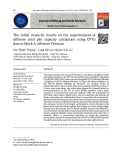
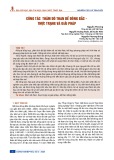

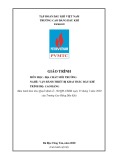


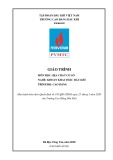
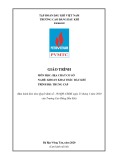
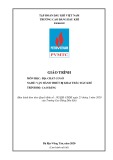




![Quy hoạch tổng thể Cà Mau: Tài liệu [mới nhất/chuẩn nhất]](https://cdn.tailieu.vn/images/document/thumbnail/2025/20250827/tghong1621@gmail.com/135x160/49401756278390.jpg)


![Bài giảng Hàng hải địa văn [chuẩn nhất]](https://cdn.tailieu.vn/images/document/thumbnail/2025/20250729/vijiraiya/135x160/43361753782101.jpg)
![Bài giảng Trắc địa cơ sở [mới nhất]](https://cdn.tailieu.vn/images/document/thumbnail/2025/20250729/vijiraiya/135x160/84_bai-giang-trac-dia-co-so.jpg)





![Atlas tài nguyên nước Việt Nam: Tài liệu [Mô tả/Hướng dẫn/Chi tiết]](https://cdn.tailieu.vn/images/document/thumbnail/2025/20250715/vijiraiya/135x160/348_tai-lieu-atlas-tai-nguyen-nuoc-viet-nam.jpg)
![Hệ thống câu hỏi ôn tập Vùng kinh tế [chuẩn nhất]](https://cdn.tailieu.vn/images/document/thumbnail/2025/20250709/kimphuong1001/135x160/76921752140578.jpg)
